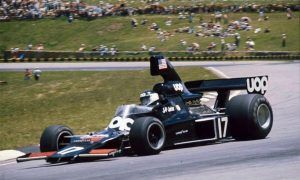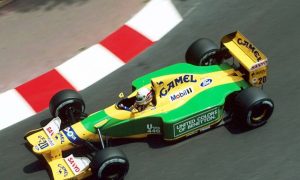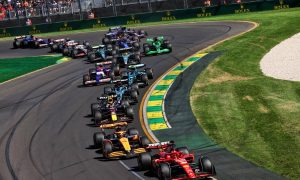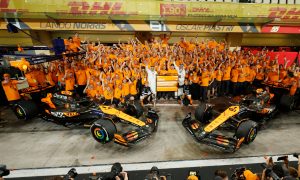You can run but you can’t hide: Eric Silbermann tracks down interesting people and forces them to have breakfast with him.
Australian race car designer and engineer Ralph Bellamy retired long before the current crop of F1 engineers had left college and he can remember working for March when a young lad by the name of Adrian Newey wrote in asking for a job. I worked with Ralph at the Larrousse-Calmels team in 1987, so I was delighted to catch up with him here in the paddock. He’s a guest of one time racer now TV commentator Christian Danner and their association dates back to 1985 when the Aussie designed the March 85B with which the German won the inaugural F3000 title. McLaren, Brabham, Team Lotus and Fittipaldi Automotive all feature on Bellamy’s F1 cv, as well as stints in Indycar and touring cars.
When was the last time you were in an F1 paddock?
As near as I can guess, professionally was ‘95 at the British Grand Prix. I was working for BMW on Touring Cars and that was a support race. I was in the paddock and saw things the way they were then but since then, I’ve never really had the credentials to come in to one of Bernie’s sacred paddocks.
Have you had the desire to come and see?
My main interest is to look at the cars and also to catch up with a few of the people that I’ve known over the years. It’s surprising the number of them that are still here.
It’s a life sentence.
Yes. I think once you get bitten by the bug, it’s pretty difficult to shake it.
You’re still doing a bit, are you?
I go racing for fun now because you can’t get it out of your system so you’ve just got to acknowledge the fact that it’s there. I do a little bit of design work and I go racing with the local BMW dealer, have done for 15 years now. It’s a weekend away with the boys. I don’t try and impose myself on them. If they ask, I will give them the benefit of my experience and so forth, but other than, I just hover in the background and help.
I still draw on a drawing board. I never learned how to use CAD
The technology’s moved on at such a pace. A car is still a car and it will still do the same things but all the tools you’ve got as an engineer have really evolved. Have you kept up with that?
No. I still draw on a drawing board. I never learned how to use CAD because CAD was becoming important towards the end of my career and I was too senior to take the time off to go and learn to use it. CAD is one of those things that you’ve got to be using all the time to be good at it. You’ve got to know where all the icons are on the screen automatically.
Let’s go back right to the beginning. The love of motor racing, how did that start?
I went to the UK with the idea to go ocean yacht racing and do the Fastnet race and things like that.
You were qualified then as an engineer?
Yeah, I was an engineer. But my timing was bad because the Fastnet only run every couple years and the year that I got there, it wasn’t run so I just fiddled around in the Med on boats and stuff. Then when the winter of 67/68 was coming on, I realised that I was going to need somewhere to go indoors where somebody else was paying the heating bill if I was going to stay in the UK and then through a friend I heard that Ron Tauranac was looking for a draftsman and I thought, well... It was quite near. I was living in Weybridge which is just round the corner.
So I went round and talked to Ron and he conned me into starting the next day and I had also the option to go skiing with my mates and thought “What am I going to do?” so I thought “Well I did tell him that I would come the next day…” So I went and that’s the start of a long and dreadful story.
What was the F1 first car you worked on?
It would have been the BT26 tube frame car. Lovely car. Jacky Ickx, who I obviously worked with at Lotus subsequently, said it was one of the nicest cars he ever drove, loved it, and he wanted to know where he could get one for his collection. That’s when we started to add wings to cars. Single-seater racing cars have evolved over the years and they take quantum jumps and putting wings on was one of the early quantum jumps.
Were you a fan of wings?
It was good. It gave you the ability to do more things with the car. I was never trained in aerodynamics but you had to start to pick up this new technology. Then we moved on and everybody got into monocoques and stuff like that, and sheet metal construction and so forth but for me, the 1970s were great years for Formula 1 racing. There were no pit stops. If you stopped, you were out of it. The whole field came round in one big snarling bunch. It was great racing. The cars were simple but effective. The competition was fantastic.
What was your favourite time? Where was your happiest working environment?
You’ve always got to have the money to do a good job and Team Lotus had the money and the infrastructure, so that’s where I did my best work. That’s where, with Peter Wright, we came up with the concept of ground effect. That was another quantum step because once we’d done that, you couldn’t un-invent it, you couldn’t go back, every car had to have it and still to this day, they concentrate on underbody aerodynamics.
Colin Chapman?
Colin and I got on well because he understood that I was a competent engineer, so we had a rapport that the non-technical people in the Lotus organisation didn’t have but he was still... he had difficult aspects to his personality, put it that way. When I designed the Lotus 78, we kept it back, because he decided he didn’t want other people to see it until the following year and then he had a really low-key, very un-John Player Special Chapman-like launch of the thing up at Hethel. Nobody came but Peter Windsor came and I gave Peter an interview saying that I’d designed the car and stuff like that and Peter printed it in Autosport and Chapman apparently went absolutely ape.
Because you said you designed it.
He never said a word to me. I just got promoted sideways into the passenger car factory. There’s suddenly a load of challenges in Lotus cars that needed addressing and so I spent a year, the first year that they raced the 78, in Lotus cars.
That was your punishment.
That was my punishment for designing a world-beating car. We should have won the world championship of course but Colin was not satisfied with having the best chassis in the world by a long shot. He decided to go and do a deal with Cosworth for development engines which of course grenaded all over the place. If you look at the results for the year, you’ll see that there were a lot of engine failures, so we didn’t win the world championship, which we should have done. They won it the next year. But Colin wanted to get rid of the 78 and that’s when they built the 79, which was not a particularly good car in a lot of ways. He’d have been better off developing the 78. What the 78 needed was a different rear suspension to clear up the aerodynamics at the back of the car and it would have been a better car because it had a better chassis, but that’s all history. That’s an engineer’s opinion.










